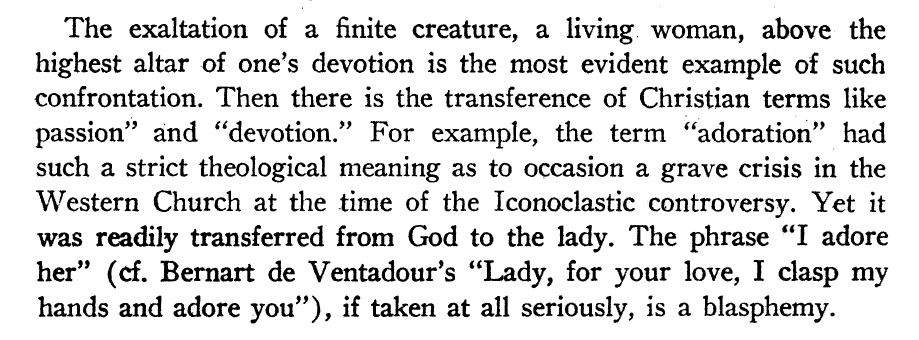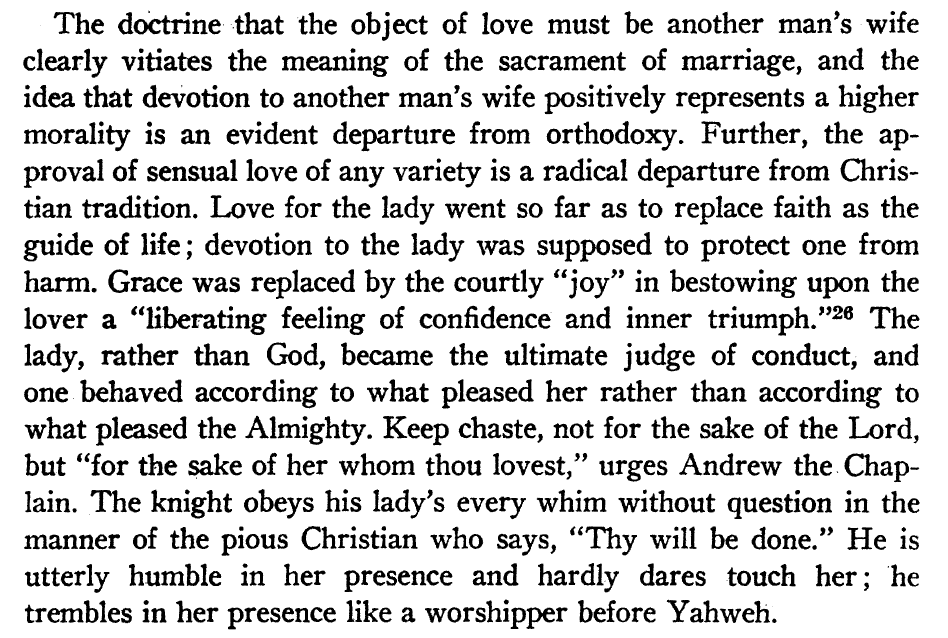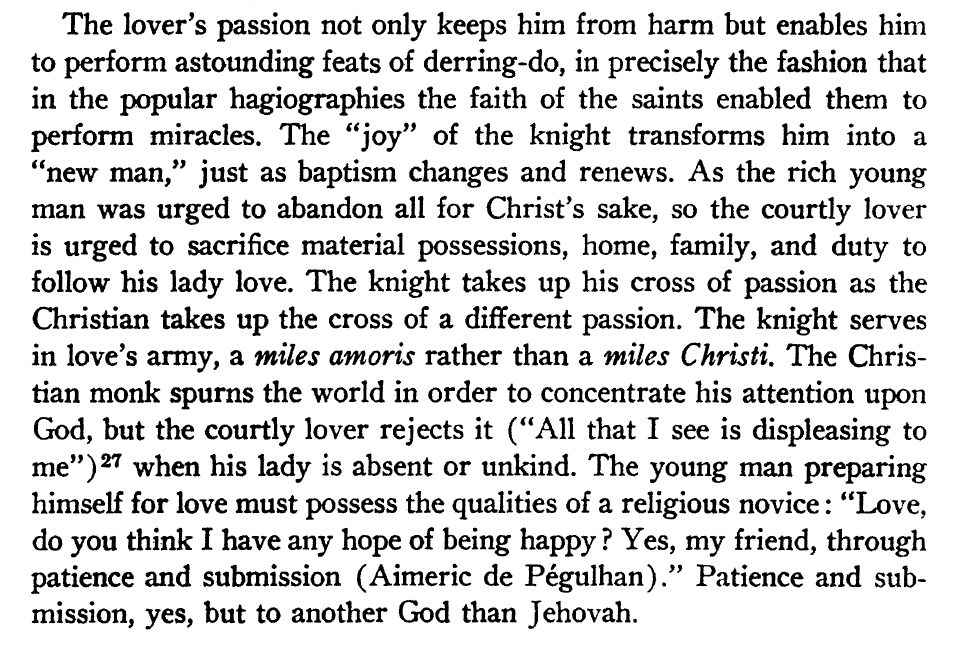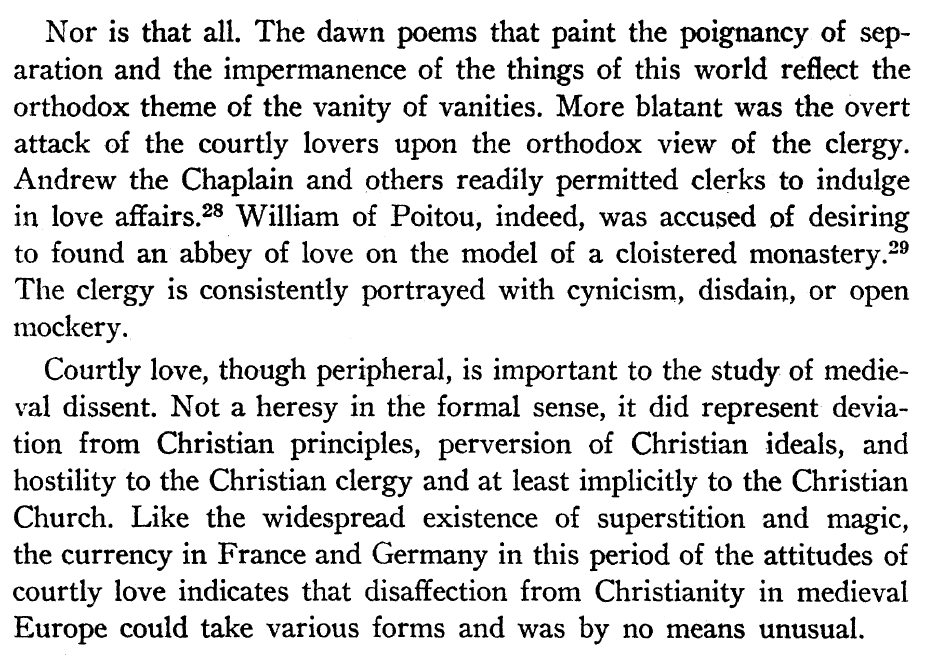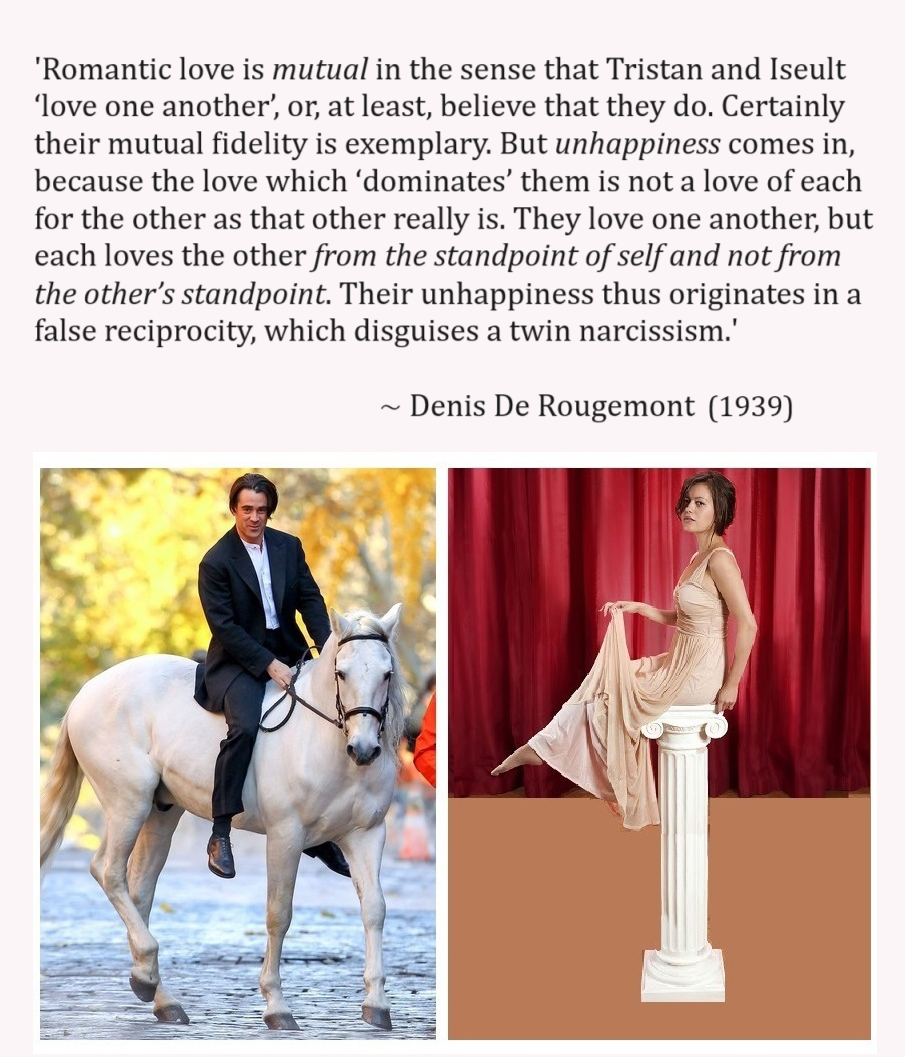The following are excerpts from Courtly Love as Religious Dissent – by Jeffrey B. Russell (1965).
Author: gynocentrism
Love in the Song of Songs
In the lead up to Valentine’s Day when Christian (and other) women look forward to receiving romantic love overtures from men. So I thought I would ask AI to clarify what is the nature of love as portrayed in the most famous lovers book in the Bible.
Question: “What is the Hebrew word used for the kind of love portrayed in the Song Of Solomon?”
ANSWER: The primary Hebrew word for love in the context of the Song of Solomon is ‘ahabah’. Although it does not explicitly refer to romantic love or sexual desire, within the context of this love song, it conveys deep affection, longing, and desire.
Even in the Septuagint, which includes a Greek translation of the Song of Songs, the word used is agape, though clearly the term eros is also applicable to the descriptions of longing and desire that take place between the two lovers.
Ahabah, agape and eros described in Songs are examples of reciprocal love, unlike the unidirectional, medieval practice of romantic love which requires sycophantic male love service toward pedestalised women. With these distinctions in mind, we can say that Christians who wish to celebrate romantic love, whether on Valentine’s or any other day, can be justifiably be charged with practicing heretical versions of love.
As a second note of clarification, St. Valentine had nothing to do with the concept of romantic love during his life, nor did romantic love play a part in the early legends that surrounded him. His namesake only later became associated with courtly & romantic love through a fanciful revisionism in the Middle Ages via poets like Chaucer who fabricated a link between the saint and romantic love. That conflation was continued by William Shakespeare, John Donne and many other poets, leading to the popular conception of romantic chivalry we inherit in today’s Valentine’s celebration.
Romantic love & cuckoldry of husbands
The invention of romantic chivalry/love in the Middle Ages taught women to view extra-marital love as more rewarding than their marriages, giving the first signs of attack on husbands and marriage that would culminate in cuckolding, frivolous marriages and the removal of fault-based divorce.
The cuckolding is showcased in famous tales of romantic chivalry: Tristan and Iseult, Lancelot and Guinevere, and in the lives of real men and women from that period forward: ie. Romantic interests trump marriage.
Enter OnlyFans wives.
Note (below) the appalling situation that husbands were originally placed in, leading modern husbands to accede to women’s romantic interests. Tradcons today continue to make noise about the importance of romantic “date nights” which are attempts to make their marriages romantically titillating in the assessment of wives.
Below is an excerpt from Valency’s In Praise of Love: An Introduction to the Love-Poetry of the Renaissance (1958):
Source: Maurice Valency, In Praise of Love: An Introduction to the Love-Poetry of the Renaissance (1958)
Female sexual desire as described in the Middle Ages
The following is from Maurice Valency’s In Praise Of Love, on the topic of female sexuality as it was observed in the Middle Ages. Note how different is this conception from contemporary fantasies on the nature of male and female sexuality.
I want a man who will “spoil” me on Valentine’s Day
We often hear women say they want a man “to spoil” them on Valentine’s Day, or indeed on other occasions. After the event they might say they “feel spoiled.” Many women expect that spoiling experience so much that they will complain with an air of aggrieved entitlement if it doesn’t eventuate.
What exactly does this term mean, and where did it originate?
The word spoiled was derived from the Latin and Old French verb spoil, which meant “to strip, rob, plunder, or pillage.” The term was also used to describe something that was “destroyed, ruined, damaged so as to render useless.” The word was first applied as a metaphor, in the year 1640, to children or to women who were “over-indulged, injured in character by excessive lenience,” and carried the additional meaning of “to become tainted or unsavory, go bad, and lose freshness” – in other words a reference to something that has gone rotten, like a piece of stinking fish or old fruit.
The metaphor of spoiling later became synonymous with pampering women in the context of romantic relationships, where a man would treat a woman like a queen or a princess and indulge her with chivalric deference and love service. The implication here is that spoiling is synonymous with the spoiler going too far on behalf of spoilee, to the degree that it creates character damage.
A Google search for mentions of spoiling someone on Valentine’s Day returned the following results:
“Spoiled her” – 409, 000 results
“Spoiled him” – 24, 000 results
That’s a differential of 17:1 in favor of women being recipients of the spoiling experience. If we take spoiling a partner on Valentine’s Day or any other occasion as a measure of narcissistic entitlement, then it appears women are doing very well despite the negative implications for character development.
To finish I will leave you with the following comments about what Valentine’s Day means for men, or rather what it apparently should mean for men according to advice columnist and relationship expert Brooke Miller who insists on the spoiling treatment for women. She writes:
First lesson: Valentine’s Day matters. This really isn’t debatable my darlings, just trust me on this one. Second lesson: Valentine’s Day matters because… Because it’s not really about Valentine’s Day…it’s a metaphor. Valentine’s Day is a metaphor for every other moment throughout the entire duration of your relationship when the woman in your life needs and wants and hopes you are able to joyfully and proudly step out of your way, and make it about her.
Valentine’s Day is a holiday decorated with girly-pink-sparkly-chocolate-flowery-hearts…and and and. February 14th could not be less stereotypically masculine if it tried. Although this holiday may not be about you, it is in fact, for you. It gifts you the opportunity to demonstrate the kind of guy you can be when put in a situation that is not about you. It shows that beautiful human being you’re lucky to be with that you, you amazing man, are able to show up selflessly to any occasion.
Valentine’s Day gives your crush or girlfriend or fiancé or wife, either a taste or a reminder (women love being reminded) of your ability to care about things not because you care about them, but because you care about her… and she cares about things. Get it?
Women know very well that Valentine’s Day doesn’t particularly matter to you, but making it matter to you, simply and solely for her… now that’s a guy worth being with. An acknowledgment of the day, a card, flowers, or even a romantic gift like a massage or spa treatment (hint hint) shows your capacity to put yourself aside even if she doesn’t ask you to–especially if she doesn’t ask you to… and put her first.1
After reading Brooke’s advice, I hope we better appreciate the meaning of this little phrase to spoil, and its social consequences. Our ability to cultivate healthy, reciprocal relationships indicates that this particular practice needs to be nipped in the bud before it descends into unsalvageable narcissism.
* * *
[1] Brooke on Boys: Why Valentine’s Day Matters, Primer Magazine: A Guy’s Post-College Guide to Growing Up.
Ambrose Bierce (1842-1914) predicted collapse of America due to gyneolatry
Ashes Of The Beacon is a prose work by Ambrose Bierce, an American writer known for his satirical and cynical style. The work is divided into four volumes and was published between 1907 and 1912. Ashes Of The Beacon is a futuristic and dystopian vision of the history and decline of the United States of America, written from the perspective of a historian who is looking back from the year 4930. The work criticizes the failures of democracy, capitalism, religion, and especially gynocentric culture in America. It is considered one of Bierce’s most controversial and provocative works, and has been compared to George Orwell’s Nineteen Eighty-Four and Aldous Huxley’s Brave New World. The following is an excerpt from the work. – PW
* * * *
‘ASHES OF THE BEACON’
An Historical Monograph Written in 4930
Of the many causes that conspired to bring about the lamentable failure of “self-government” in ancient America the most general and comprehensive was, of course, the impracticable nature of the system itself.
The ancient Americans were a composite people; their blood was a blend of all the strains known in their time. Their government, while they had one, being merely a loose and mutable expression of the desires and caprices of the majority—that is to say, of the ignorant, restless and reckless—gave the freest rein and play to all the primal instincts and elemental passions of the race. In so far and for so long as it had any restraining force, it was only the restraint of the present over the power of the past—that of a new habit over an old and insistent tendency ever seeking expression in large liberties and indulgences impatient of control. In the history of that unhappy people, therefore, we see unveiled the workings of the human will in its most lawless state, without fear of authority or care of consequence. Nothing could be more instructive. […]
A singular phenomenon of the time was the immunity of criminal women. Among the Americans woman held a place unique in the history of nations. If not actually worshiped as a deity, as some historians, among them the great Sagab-Joffoy, have affirmed, she was at least regarded with feelings of veneration which the modern mind has a difficulty in comprehending. Some degree of compassion for her mental inferiority, some degree of forbearance toward her infirmities of temper, some degree of immunity for the offenses which these peculiarities entail—these are common to all peoples above the grade of barbarians. In ancient America these chivalrous sentiments found open and lawful expression only in relieving woman of the burden of participation in political and military service; the laws gave her no express exemption from responsibility for crime. When she murdered, she was arrested; when arrested, brought to trial—though the origin and meaning of those observances are not now known.
Gunkux, whose researches into the jurisprudence of antiquity enable him to speak with commanding authority of many things, gives us here nothing better than the conjecture that the trial of women for murder, in the nineteenth century and a part of the twentieth, was the survival of an earlier custom of actually convicting and punishing them, but it seems extremely improbable that a people that once put its female assassins to death would ever have relinquished the obvious advantages of the practice while retaining with purposeless tenacity some of its costly preliminary forms.
Whatever may have been the reason, the custom was observed with all the gravity of a serious intention. Gunkux professes knowledge of one or two instances (he does not name his authorities) where matters went so far as conviction and sentence, and adds that the mischievous sentimentalists who had always lent themselves to the solemn jest by protestations of great vraisemblance against “the judicial killing of women,” became really alarmed and filled the land with their lamentations.
Among the phenomena of brazen effrontery he classes the fact that some of these loud protagonists of the right of women to assassinate unpunished were themselves women! Howbeit, the sentences, if ever pronounced, were never executed, and during the first quarter of the twentieth century the meaningless custom of bringing female assassins to trial was abandoned. What the effect was of their exemption from this considerable inconvenience we have not the data to conjecture, unless we understand as an allusion to it some otherwise obscure words of the famous Edward Bok, the only writer of the period whose work has survived. In his monumental essay on barbarous penology, entitled “Slapping the Wrist,” he couples “woman’s emancipation from the trammels of law” and “man’s better prospect of death” in a way that some have construed as meaning that he regarded them as cause and effect. It must be said, however, that this interpretation finds no support in the general character of his writing, which is exceedingly humane, refined and womanly.
It has been said that the writings of this great man are the only surviving work of his period, but of that we are not altogether sure. There exists a fragment of an anonymous essay on woman’s legal responsibility which many Americologists think belongs to the beginning of the twentieth century. Certainly it could not have been written later than the middle of it, for at that time woman had been definitely released from any responsibility to any law but that of her own will. The essay is an argument against even such imperfect exemption as she had in its author’s time.
“It has been urged,” the writer says, “that women, being less rational and more emotional than men, should not be held accountable in the same degree. To this it may be answered that punishment for crime is not intended to be retaliatory, but admonitory and deterrent. It is, therefore, peculiarly necessary to those not easily reached by other forms of warning and dissuasion. Control of the wayward is not to be sought in reduction of restraints, but in their multiplication. One who cannot be curbed by reason may be curbed by fear, a familiar truth which lies at the foundation of all penological systems.
The argument for exemption of women is equally cogent for exemption of habitual criminals, for they too are abnormally inaccessible to reason, abnormally disposed to obedience to the suasion of their unregulated impulses and passions. To free them from the restraints of the fear of punishment would be a bold innovation which has as yet found no respectable proponent outside their own class.
“Very recently this dangerous enlargement of the meaning of the phrase ‘emancipation of woman’ has been fortified with a strange advocacy by the female ‘champions of their sex.’ Their argument runs this way: ‘We are denied a voice in the making of the laws relating to infliction of the death penalty; it is unjust to hold us to an accountability to which we have not assented.’ Of course this argument is as broad as the entire body of law; it amounts to nothing less than a demand for general immunity from all laws, for to none of them has woman’s assent been asked or given. But let us consider this amazing claim with reference only to the proposal in the service and promotion of which it is now urged: exemption of women from the death penalty for murder. In the last analysis it is seen to be a simple demand for compensation. It says: ‘You owe us a solatium. Since you deny us the right to vote, you should give us the right to assassinate. We do not appraise it at so high a valuation as the other franchise, but we do value it.’
“Apparently they do: without legal, but with virtual, immunity from punishment, the women of this country take an average of one thousand lives annually, nine in ten being the lives of men. Juries of men, incited and sustained by public opinion, have actually deprived every adult male American of the right to live. If the death of any man is desired by any woman for any reason he is without protection. She has only to kill him and say that he wronged or insulted her. Certain almost incredible recent instances prove that no woman is too base for immunity, no crime against life sufficiently rich in all the elements of depravity to compel a conviction of the assassin, or, if she is convicted and sentenced, her punishment by the public executioner.” […]
A remarkable feature of the crude and primitive civilization of the Americans was their religion. This was polytheistic, as is that of all backward peoples, and among their minor deities were their own women. This has been disputed by respectable authorities, among them Gunkux and the younger Kekler, but the weight of archæological testimony is against them, for, as Sagab-Joffy ingeniously points out, none of less than divine rank would by even the lowest tribes be given unrestricted license to kill.
Among the American’s woman, as already pointed out, indubitably had that freedom, and exercised it with terrible effect, a fact which makes the matter of their religion pertinent to the purpose of this monograph. If ever an American woman was punished by law for murder of a man no record of the fact is found; whereas, such American literature as we possess is full of the most enthusiastic adulation of the impossible virtues and imaginary graces of the human female. One writer even goes to the length of affirming that respect for the sex is the foundation of political stability, the cornerstone of civil and religious liberty! After the break-up of the republic and the savage intertribal wars that followed, Gyneolatry was an exhausted cult and woman was relegated to her old state of benign subjection.
Source: The Collected Works of Ambrose Bierce, Volume 1 (1909)
“Dame Amour” – French personification of courtly love
Denis De Rougemont (1939): Romantic Love is “Twin narcissism”
A short word on love terminology
The various kinds of love are classified by ancient Greek terms, of which the following are examples:
- Eros: (desirous love)
- Storge: (affectionate & pairbonding love)
- Agape: (charitable love)
- Pragma: (practical/pragmatic love)
- Philia: (friendship love)
- Narcissism: (self-love)
This list captures the more common forms of love, even though more subtypes could be added. Missing from the usual lists, however, is one of the most important forms of love for the contemporary era:
- Amour: (romantic love)
In the past romantic love has been defined by the vague and meaningless catch-all term eros, a word that has lost all specificity and become synonymous with the English word love – itself another nonspecific term. For that reason I have returned eros above to its original Greek meaning of desire, and designated romantic love by the popular European term amour.
Denis de Rougemont: The root cause of the destruction of marriages (1939)
The following section from Denis de Rougemont’s book Love In The Western World discusses the breakdown of stable relationships in America and the Western world due to the influences of romantic love.
